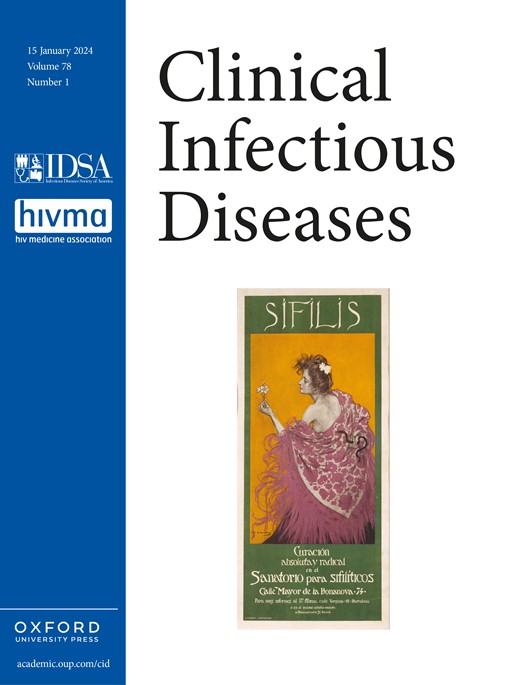The Effects of Vaccination Status and Age on Clinical Characteristics and Severity of Measles Cases in the United States in the Post-Elimination Era, 2001-2022
IF 8.2
1区 医学
Q1 IMMUNOLOGY
引用次数: 0
Abstract
Background Despite high vaccine-effectiveness, wild-type measles can occur in previously vaccinated persons. We compared the clinical presentation and disease severity of measles by vaccination status and age in the post-elimination era in the United States. Methods We included U.S. measles cases reported from 2001–2022. Breakthrough measles was defined as cases with ≥1 documented dose of measles-containing vaccine, classic measles as the presence of rash, fever, and ≥1 symptoms (cough, coryza, or conjunctivitis), and severe disease as the presence of pneumonia, encephalitis, hospitalization, or death. Vaccinated cases with low and high avidity IgG were classified as primary (PVF) and secondary (SVF) vaccine failures, respectively. Results Among 4,056 confirmed measles cases, 2,799 (69%) were unvaccinated, 475 (12%) were breakthrough infections, and 782 (19%) had unknown vaccination; 1,526 (38%), 1,174 (29%), and 1,355 (33%) were aged <5, 5–19, and ≥20 years, respectively. We observed a general decline in classic presentation and severe disease with an increase in the number of doses, and less complications among children aged 5–19 years compared to other age-groups. Among 93 breakthrough cases with avidity results, 11 (12%) and 76 (82%) were classified as PVF and SVF, respectively, with a higher proportion of PVFs having a classic measles presentation and severe disease than SVFs. Discussion Breakthrough measles cases tended to have milder disease with less complications. A small proportion of breakthrough infections were due to PVF than SVF. It is critical to maintain high MMR vaccination coverage in the United States to prevent serious measles illnesses.2001-2022 年美国麻疹疫苗接种情况和年龄对麻疹病例临床特征和严重程度的影响
背景 尽管疫苗接种效果很好,但野生型麻疹仍可能发生在以前接种过疫苗的人身上。我们比较了美国后消除麻疹时代按疫苗接种状况和年龄划分的麻疹临床表现和疾病严重程度。方法 我们纳入了 2001-2022 年间报告的美国麻疹病例。突破性麻疹是指接种含麻疹成分疫苗剂量≥1 剂的病例,典型麻疹是指出现皮疹、发热和≥1 种症状(咳嗽、流鼻涕或结膜炎),重症是指出现肺炎、脑炎、住院或死亡。疫苗接种病例的 IgG 阳性较低和较高,分别被归类为原发性(PVF)和继发性(SVF)疫苗接种失败。结果 在 4,056 例麻疹确诊病例中,2,799 例(69%)未接种疫苗,475 例(12%)突破性感染,782 例(19%)疫苗接种情况不明;1,526 例(38%)、1,174 例(29%)和 1,355 例(33%)年龄分别为 <5、5-19 和≥20 岁。我们观察到,随着用药次数的增加,典型表现和严重疾病的发病率普遍下降,与其他年龄组相比,5-19 岁儿童的并发症较少。在 93 例有抗体阳性结果的突破性病例中,分别有 11 例(12%)和 76 例(82%)被归类为 PVF 和 SVF,与 SVF 相比,PVF 具有典型麻疹表现和严重疾病的比例更高。讨论 突破性麻疹病例往往病情较轻,并发症较少。在突破性感染病例中,PVF 的比例低于 SVF。在美国保持较高的麻疹疫苗接种率对预防严重的麻疹疾病至关重要。
本文章由计算机程序翻译,如有差异,请以英文原文为准。
求助全文
约1分钟内获得全文
求助全文
来源期刊

Clinical Infectious Diseases
医学-传染病学
CiteScore
25.00
自引率
2.50%
发文量
900
审稿时长
3 months
期刊介绍:
Clinical Infectious Diseases (CID) is dedicated to publishing original research, reviews, guidelines, and perspectives with the potential to reshape clinical practice, providing clinicians with valuable insights for patient care. CID comprehensively addresses the clinical presentation, diagnosis, treatment, and prevention of a wide spectrum of infectious diseases. The journal places a high priority on the assessment of current and innovative treatments, microbiology, immunology, and policies, ensuring relevance to patient care in its commitment to advancing the field of infectious diseases.
 求助内容:
求助内容: 应助结果提醒方式:
应助结果提醒方式:


